
Over 16,534,793 people are on fubar.
What are you waiting for?

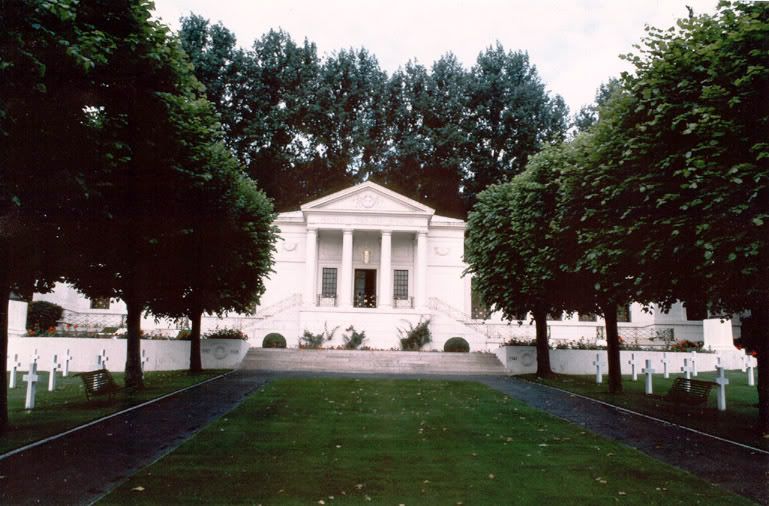 Originally a World War I cemetery, the Suresnes American Cemetery and Memorial just outside Paris, France now shelters the remains of U.S. dead of both wars. The 7.5-acre cemetery contains the remains of 1,541 Americans who died in World War I and 24 Unknown dead of World War II. Bronze tablets on the walls of the chapel record the names of 974 World War I missing. Rosettes mark the names of those since recovered and identified.
The World War I memorial chapel was enlarged by the addition of two loggias dedicated to the dead of World Wars I and II, respectively. In the rooms at the ends of the loggias are white marble figures in memory of those who lost their lives in the two wars. Inscribed on the loggia walls is a summary of the loss of life in our armed forces in each war, together with the location of the overseas commemorative cemeteries where our war dead are buried.
The cemetery is open daily to the public from 9 a.m. to 5 p.m. except December 25 and January 1. It is open on host country holidays. When the cemetery is open to the public, a staff member is on duty in the Visitor Building to answer questions and escort relatives to grave and memorial sites.
How to Get There
Suresnes American Cemetery is in the city of Suresnes, 5 miles west of the center of Paris. It can be reached by automobile, taxicab or metro and suburban trains; the latter depart about every 15 minutes from the Gare St. Lazare to the Suresnes Mont Valerien station. From the Suresnes station it is only a 10-minute walk to the cemetery. A panorama view of Paris can be seen from the site, which is located high on the slopes of Mont Valerien.
Originally a World War I cemetery, the Suresnes American Cemetery and Memorial just outside Paris, France now shelters the remains of U.S. dead of both wars. The 7.5-acre cemetery contains the remains of 1,541 Americans who died in World War I and 24 Unknown dead of World War II. Bronze tablets on the walls of the chapel record the names of 974 World War I missing. Rosettes mark the names of those since recovered and identified.
The World War I memorial chapel was enlarged by the addition of two loggias dedicated to the dead of World Wars I and II, respectively. In the rooms at the ends of the loggias are white marble figures in memory of those who lost their lives in the two wars. Inscribed on the loggia walls is a summary of the loss of life in our armed forces in each war, together with the location of the overseas commemorative cemeteries where our war dead are buried.
The cemetery is open daily to the public from 9 a.m. to 5 p.m. except December 25 and January 1. It is open on host country holidays. When the cemetery is open to the public, a staff member is on duty in the Visitor Building to answer questions and escort relatives to grave and memorial sites.
How to Get There
Suresnes American Cemetery is in the city of Suresnes, 5 miles west of the center of Paris. It can be reached by automobile, taxicab or metro and suburban trains; the latter depart about every 15 minutes from the Gare St. Lazare to the Suresnes Mont Valerien station. From the Suresnes station it is only a 10-minute walk to the cemetery. A panorama view of Paris can be seen from the site, which is located high on the slopes of Mont Valerien.
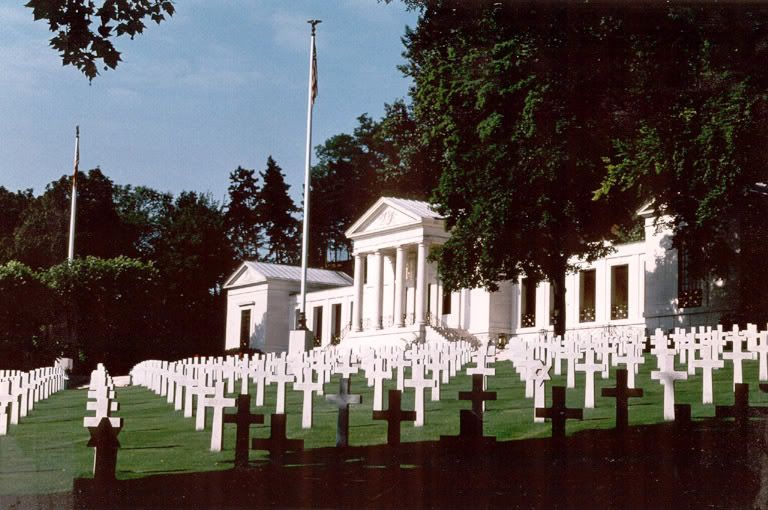
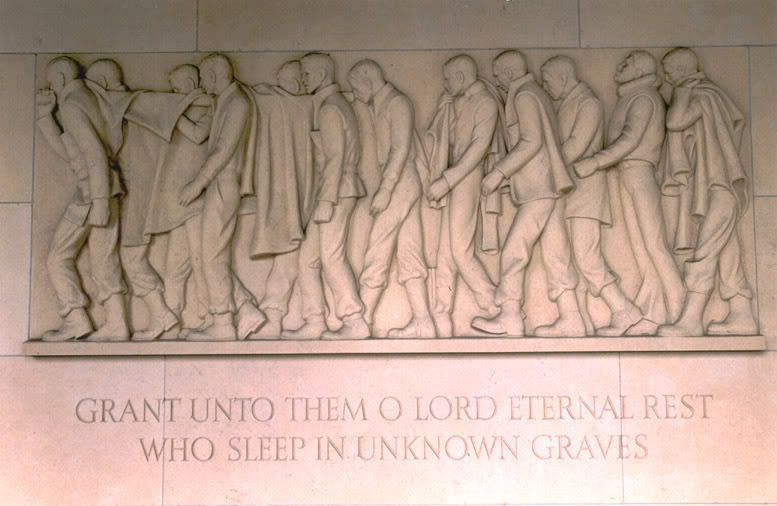
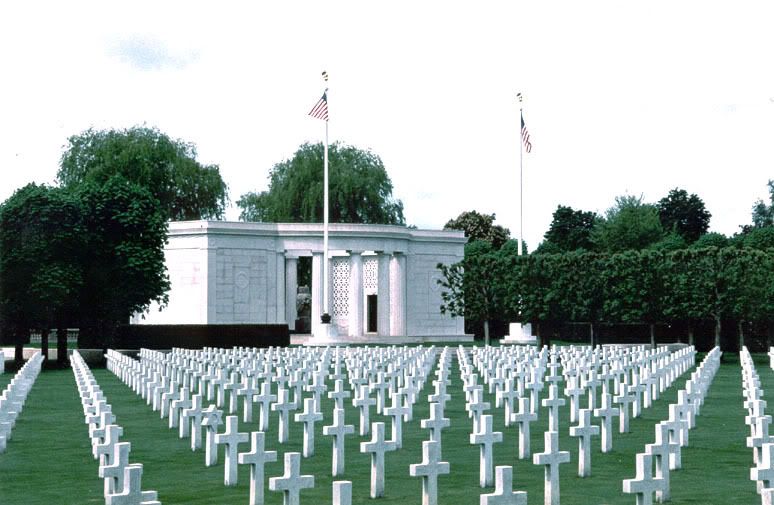 The World War I St. Mihiel American Cemetery and Memorial in France, 40.5 acres in extent, contains the graves of 4,153 of our military dead. The majority of these died in the offensive that resulted in the reduction of the St. Mihiel salient that threatened Paris. The burial area is divided by Linden alignment trees and paths into four equal plots. At the center is a large sundial surmounted by an American eagle. To the right (west) is a statue of a World War I soldier and at the eastern end is a semi-circular overlook dominated by a sculpture representing a victory vase.
Beyond the burial area to the south is the white stone memorial consisting of a small chapel, a peristyle with a large rose-granite funeral urn at its center, and a map building. The chapel contains a beautiful mosaic portraying an angel sheathing his sword. On two walls of the museum are recorded the names of 284 of the missing. Rosettes mark the names of those since recovered and identified. On the wall facing the door is a large map of inlaid marble depicting the St. Mihiel Offensive.
The cemetery is open daily to the public from 9 a.m. to 5 p.m. except December 25 and January 1. It is open on host country holidays. When the cemetery is open to the public, a staff member is on duty in the Visitor Building to answer questions and escort relatives to grave and memorial sites.
How to Get There
St. Mihiel American Cemetery is situated at the west edge of Thiaucourt (M. et M.), France. The cemetery can be reached by automobile from Paris (190 miles) via Verdun and from Metz (23 miles) via toll highway A-4 (E-50), exiting at Fresnes-en-Woëvre (Exit #32). At Fresnes-en-Woëvre, take D-904 in the direction of Pont-a-Mousson. There is direct rail service from Paris (Gare de l'Est) to Toul. Accommodations are available in Metz, Nancy and Pont-a-Mousson.
The World War I St. Mihiel American Cemetery and Memorial in France, 40.5 acres in extent, contains the graves of 4,153 of our military dead. The majority of these died in the offensive that resulted in the reduction of the St. Mihiel salient that threatened Paris. The burial area is divided by Linden alignment trees and paths into four equal plots. At the center is a large sundial surmounted by an American eagle. To the right (west) is a statue of a World War I soldier and at the eastern end is a semi-circular overlook dominated by a sculpture representing a victory vase.
Beyond the burial area to the south is the white stone memorial consisting of a small chapel, a peristyle with a large rose-granite funeral urn at its center, and a map building. The chapel contains a beautiful mosaic portraying an angel sheathing his sword. On two walls of the museum are recorded the names of 284 of the missing. Rosettes mark the names of those since recovered and identified. On the wall facing the door is a large map of inlaid marble depicting the St. Mihiel Offensive.
The cemetery is open daily to the public from 9 a.m. to 5 p.m. except December 25 and January 1. It is open on host country holidays. When the cemetery is open to the public, a staff member is on duty in the Visitor Building to answer questions and escort relatives to grave and memorial sites.
How to Get There
St. Mihiel American Cemetery is situated at the west edge of Thiaucourt (M. et M.), France. The cemetery can be reached by automobile from Paris (190 miles) via Verdun and from Metz (23 miles) via toll highway A-4 (E-50), exiting at Fresnes-en-Woëvre (Exit #32). At Fresnes-en-Woëvre, take D-904 in the direction of Pont-a-Mousson. There is direct rail service from Paris (Gare de l'Est) to Toul. Accommodations are available in Metz, Nancy and Pont-a-Mousson.

 The World War I Somme American Cemetery and Memorial in France is sited on a gentle slope typical of the open, rolling Picardy countryside. The 14.3-acre cemetery contains the graves of 1,844 of our military dead. Most lost their lives while serving in American units attached to British armies, or in operations near Cantigny. The headstones, set in regular rows, are separated into four plots by paths that intersect at the flagpole near the top of the slope. The longer axis leads to the chapel at the eastern end of the cemetery.
A massive bronze door surmounted by an American eagle leads into the chapel, whose outer walls contain sculptured pieces of military equipment. Once inside, light from a cross-shaped crystal window above the marble altar bathes the subdued interior with light. The walls bear the names of 333 of the missing. Rosettes mark the names of those since recovered and identified.
The cemetery is open daily to the public from 9 a.m. to 5 p.m. except December 25 and January 1. It is open on host country holidays. When the cemetery is open to the public, a staff member is on duty in the Visitor Building to answer questions and escort relatives to grave and memorial sites.
How to Get There
Somme American Cemetery is situated ½ mile southwest of the village of Bony (Aisne), France, which is 1¼ miles west of highway N-44, 13 miles north of St. Quentin and 14 miles southwest of Cambrai. The road leading to Bony leaves highway N-44 10 miles north of St. Quentin, a short distance north of the American monument near Bellicourt. The cemetery, 98 miles northeast of Paris, can also be reached by automobile via the Paris-Lille toll autoroute (A-1) to exit 13, "Vallée de la Somme," then to Vermand and Bellenglise, or Lille-Reims toll autoroute (A-26) exit 9, via highway N-44 south for 7½ miles to Bony. Hotels are available at Peronne, St. Quentin, and Cambrai, which may be reached by train from Paris (Gare du Nord).
The World War I Somme American Cemetery and Memorial in France is sited on a gentle slope typical of the open, rolling Picardy countryside. The 14.3-acre cemetery contains the graves of 1,844 of our military dead. Most lost their lives while serving in American units attached to British armies, or in operations near Cantigny. The headstones, set in regular rows, are separated into four plots by paths that intersect at the flagpole near the top of the slope. The longer axis leads to the chapel at the eastern end of the cemetery.
A massive bronze door surmounted by an American eagle leads into the chapel, whose outer walls contain sculptured pieces of military equipment. Once inside, light from a cross-shaped crystal window above the marble altar bathes the subdued interior with light. The walls bear the names of 333 of the missing. Rosettes mark the names of those since recovered and identified.
The cemetery is open daily to the public from 9 a.m. to 5 p.m. except December 25 and January 1. It is open on host country holidays. When the cemetery is open to the public, a staff member is on duty in the Visitor Building to answer questions and escort relatives to grave and memorial sites.
How to Get There
Somme American Cemetery is situated ½ mile southwest of the village of Bony (Aisne), France, which is 1¼ miles west of highway N-44, 13 miles north of St. Quentin and 14 miles southwest of Cambrai. The road leading to Bony leaves highway N-44 10 miles north of St. Quentin, a short distance north of the American monument near Bellicourt. The cemetery, 98 miles northeast of Paris, can also be reached by automobile via the Paris-Lille toll autoroute (A-1) to exit 13, "Vallée de la Somme," then to Vermand and Bellenglise, or Lille-Reims toll autoroute (A-26) exit 9, via highway N-44 south for 7½ miles to Bony. Hotels are available at Peronne, St. Quentin, and Cambrai, which may be reached by train from Paris (Gare du Nord).
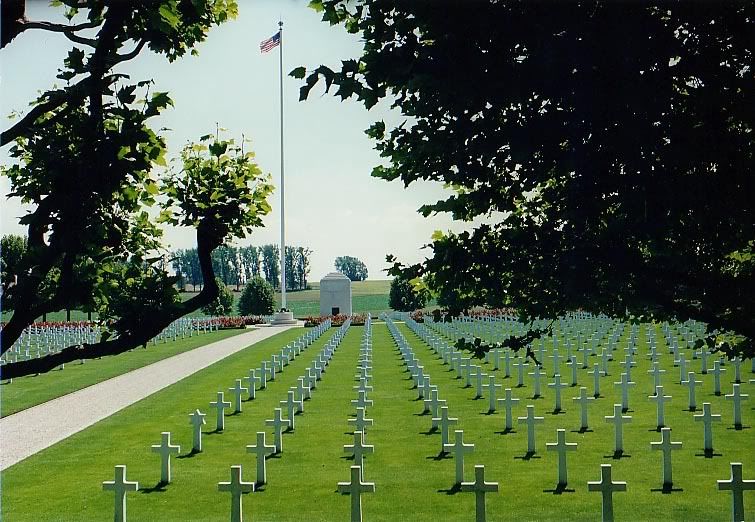
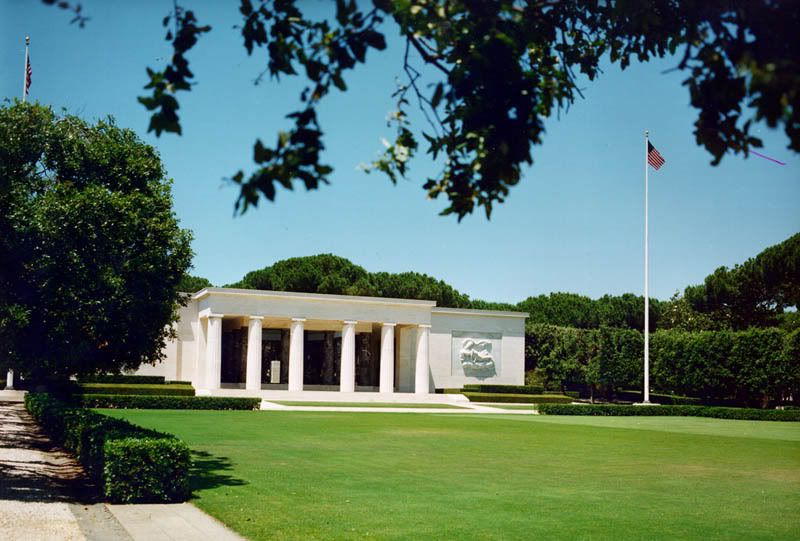 The World War II Sicily-Rome American Cemetery and Memorial site in Italy covers 77 acres, rising in a gentle slope from a broad pool with an island and cenotaph flanked by groups of Italian cypress trees. Beyond the pool is the immense field of headstones of 7,861 of American military war dead, arranged in gentle arcs on broad green lawns beneath rows of Roman pines. The majority of these men died in the liberation of Sicily (July 10 to August 17, 1943); in the landings in the Salerno Area (September 9, 1943) and the heavy fighting northward; in the landings at Anzio Beach and expansion of the beachhead (January 22, 1944 to May 1944); and in air and naval support in the regions.
A wide central mall leads to the memorial, rich in works of art and architecture, expressing America's remembrance of the dead. It consists of a chapel to the south, a peristyle, and a map room to the north. On the white marble walls of the chapel are engraved the names of 3,095 of the missing. Rosettes mark the names of those since recovered and identified. The map room contains a bronze relief map and four fresco maps depicting the military operations in Sicily and Italy. At each end of the memorial are ornamental Italian gardens.
The cemetery is open daily to the public from 9 a.m. to 5 p.m. except December 25 and January 1. It is open on host country holidays. When the cemetery is open to the public, a staff member is on duty in the Visitor Building to answer questions and escort relatives to grave and memorial sites.
How to Get There
Sicily-Rome American Cemetery lies at the north edge of the town of Nettuno, Italy, which is immediately east of Anzio, 38 miles south of Rome. The cemetery can be reached by automobile from Rome along the Via Cristoforo Colombo, which runs into Via Pontina (highway 148). Drive south approximately 37 miles and exit at Campoverde/Nettuno. Turn right to Nettuno, continuing 5½ miles to the cemetery. There is hourly train service from Rome to Nettuno, where taxicabs can be hired. There are numerous hotels in Anzio and Nettuno.
The World War II Sicily-Rome American Cemetery and Memorial site in Italy covers 77 acres, rising in a gentle slope from a broad pool with an island and cenotaph flanked by groups of Italian cypress trees. Beyond the pool is the immense field of headstones of 7,861 of American military war dead, arranged in gentle arcs on broad green lawns beneath rows of Roman pines. The majority of these men died in the liberation of Sicily (July 10 to August 17, 1943); in the landings in the Salerno Area (September 9, 1943) and the heavy fighting northward; in the landings at Anzio Beach and expansion of the beachhead (January 22, 1944 to May 1944); and in air and naval support in the regions.
A wide central mall leads to the memorial, rich in works of art and architecture, expressing America's remembrance of the dead. It consists of a chapel to the south, a peristyle, and a map room to the north. On the white marble walls of the chapel are engraved the names of 3,095 of the missing. Rosettes mark the names of those since recovered and identified. The map room contains a bronze relief map and four fresco maps depicting the military operations in Sicily and Italy. At each end of the memorial are ornamental Italian gardens.
The cemetery is open daily to the public from 9 a.m. to 5 p.m. except December 25 and January 1. It is open on host country holidays. When the cemetery is open to the public, a staff member is on duty in the Visitor Building to answer questions and escort relatives to grave and memorial sites.
How to Get There
Sicily-Rome American Cemetery lies at the north edge of the town of Nettuno, Italy, which is immediately east of Anzio, 38 miles south of Rome. The cemetery can be reached by automobile from Rome along the Via Cristoforo Colombo, which runs into Via Pontina (highway 148). Drive south approximately 37 miles and exit at Campoverde/Nettuno. Turn right to Nettuno, continuing 5½ miles to the cemetery. There is hourly train service from Rome to Nettuno, where taxicabs can be hired. There are numerous hotels in Anzio and Nettuno.
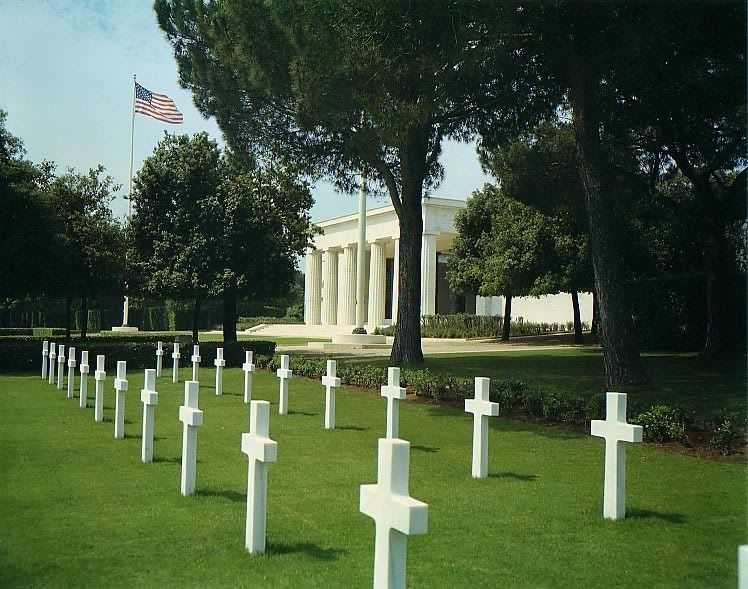
 The site of the Rhone American Cemetery and Memorial in France was selected because of its historic location along the route of the U.S. Seventh Army's drive up the Rhone Valley. It was established on August 19, 1944 after the Seventh Army's surprise landing in southern France.
On 12.5 acres at the foot of a hill clad with the characteristic cypresses, olive trees, and oleanders of southern France rest 861 of our military dead, most of whom lost their lives in the liberation of southern France in August 1944. Their headstones are arranged in straight lines, divided into four plots, and grouped about an oval pool. At each end of the cemetery is a small garden. On the hillside overlooking the cemetery is the chapel with its wealth of decorative mosaic and large sculptured figures. Between the chapel and the burial area, a bronze relief map recalls military operations in the region. On the retaining wall of the terrace, 294 names of the missing are inscribed. Rosettes mark the names of those since recovered and identified.
The cemetery is open daily to the public from 9 a.m. to 5 p.m. except December 25 and January 1. It is open on host country holidays. When the cemetery is open to the public, a staff member is on duty in the Visitor Building to answer questions and escort relatives to grave and memorial sites.
How to Get There
Rhone American Cemetery is in the city of Draguignan (Var), France, 40 miles west of Cannes and 16 miles inland. It can be reached from Paris-Marseille-St. Raphael-Nice by Autoroute A6/A7/A8 (toll highway) by taking the Le Muy exit onto highway N-555 to Draguignan. From Cannes the cemetery is best reached via Autoroute A8. It also may be reached via Grasse on highway N-85 and D-562, or highway N-7 via Frejus and Le Muy or Les Arcs to Draguignan. Trains from Cannes, Marseille and Paris stop at St. Raphael where taxicab and bus services are available. Some trains stop at Les Arcs where bus and taxicab services are also available. Hotel accommodations in Draguignan are limited but there are many hotels in St. Raphael, Cannes and other Riviera cities.
The site of the Rhone American Cemetery and Memorial in France was selected because of its historic location along the route of the U.S. Seventh Army's drive up the Rhone Valley. It was established on August 19, 1944 after the Seventh Army's surprise landing in southern France.
On 12.5 acres at the foot of a hill clad with the characteristic cypresses, olive trees, and oleanders of southern France rest 861 of our military dead, most of whom lost their lives in the liberation of southern France in August 1944. Their headstones are arranged in straight lines, divided into four plots, and grouped about an oval pool. At each end of the cemetery is a small garden. On the hillside overlooking the cemetery is the chapel with its wealth of decorative mosaic and large sculptured figures. Between the chapel and the burial area, a bronze relief map recalls military operations in the region. On the retaining wall of the terrace, 294 names of the missing are inscribed. Rosettes mark the names of those since recovered and identified.
The cemetery is open daily to the public from 9 a.m. to 5 p.m. except December 25 and January 1. It is open on host country holidays. When the cemetery is open to the public, a staff member is on duty in the Visitor Building to answer questions and escort relatives to grave and memorial sites.
How to Get There
Rhone American Cemetery is in the city of Draguignan (Var), France, 40 miles west of Cannes and 16 miles inland. It can be reached from Paris-Marseille-St. Raphael-Nice by Autoroute A6/A7/A8 (toll highway) by taking the Le Muy exit onto highway N-555 to Draguignan. From Cannes the cemetery is best reached via Autoroute A8. It also may be reached via Grasse on highway N-85 and D-562, or highway N-7 via Frejus and Le Muy or Les Arcs to Draguignan. Trains from Cannes, Marseille and Paris stop at St. Raphael where taxicab and bus services are available. Some trains stop at Les Arcs where bus and taxicab services are also available. Hotel accommodations in Draguignan are limited but there are many hotels in St. Raphael, Cannes and other Riviera cities.

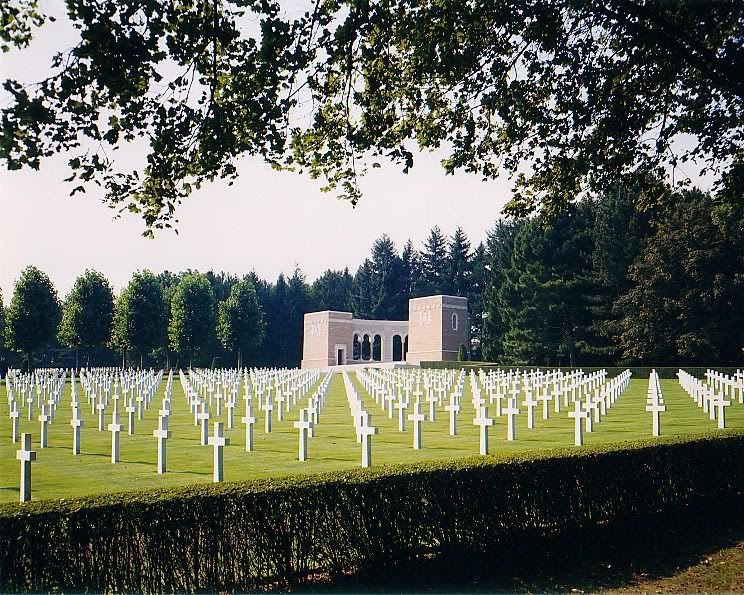 The Oise-Aisne American Cemetery and Memorial in France contains the remains of 6,012 American war dead, most of whom lost their lives while fighting in this vicinity in 1918 during the First World War. Their headstones, aligned in long rows on the 36.5-acre site, rise in a gentle slope from the entrance to the memorial at the far end. The burial area is divided into four plots by wide paths lined by trees and beds of roses; at the intersection are a circular plaza and the flagpole.
The memorial is a curving colonnade, flanked at the ends by a chapel and a map room. It is built of rose-colored sandstone with white trim bearing sculptured details of wartime equipment. The chapel contains an altar of carved stone. Engraved upon its Walls of the Missing are 241 names. Rosettes mark the names of those since recovered and identified. The map room contains an engraved and colored wall map portraying the military operations in this region during 1918.
The cemetery is open daily to the public from 9 a.m. to 5 p.m. except December 25 and January 1. It is open on host country holidays. When the cemetery is open to the public, a staff member is on duty in the Visitor Building to answer questions and escort relatives to grave and memorial sites.
How to Get There
Oise-Aisne American Cemetery lies 1½ miles east of Fère-en-Tardenois (Aisne), France, which is 14 miles northeast of Chateau-Thierry. It may be reached by automobile from Paris by toll autoroute A-4 taking the Chateau-Thierry exit (49½ miles), turn left onto highway D-1, continue to Fère-en-Tardenois (12 miles). Hotels are available in Chateau-Thierry, Reims (27 miles) and Soissons (18 miles). There is rail service to each of these cities where taxicabs may be hired.
The Oise-Aisne American Cemetery and Memorial in France contains the remains of 6,012 American war dead, most of whom lost their lives while fighting in this vicinity in 1918 during the First World War. Their headstones, aligned in long rows on the 36.5-acre site, rise in a gentle slope from the entrance to the memorial at the far end. The burial area is divided into four plots by wide paths lined by trees and beds of roses; at the intersection are a circular plaza and the flagpole.
The memorial is a curving colonnade, flanked at the ends by a chapel and a map room. It is built of rose-colored sandstone with white trim bearing sculptured details of wartime equipment. The chapel contains an altar of carved stone. Engraved upon its Walls of the Missing are 241 names. Rosettes mark the names of those since recovered and identified. The map room contains an engraved and colored wall map portraying the military operations in this region during 1918.
The cemetery is open daily to the public from 9 a.m. to 5 p.m. except December 25 and January 1. It is open on host country holidays. When the cemetery is open to the public, a staff member is on duty in the Visitor Building to answer questions and escort relatives to grave and memorial sites.
How to Get There
Oise-Aisne American Cemetery lies 1½ miles east of Fère-en-Tardenois (Aisne), France, which is 14 miles northeast of Chateau-Thierry. It may be reached by automobile from Paris by toll autoroute A-4 taking the Chateau-Thierry exit (49½ miles), turn left onto highway D-1, continue to Fère-en-Tardenois (12 miles). Hotels are available in Chateau-Thierry, Reims (27 miles) and Soissons (18 miles). There is rail service to each of these cities where taxicabs may be hired.
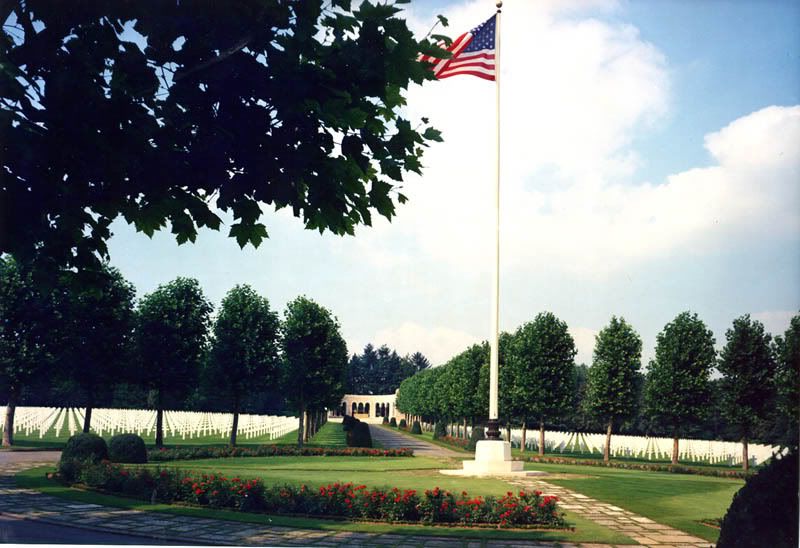
 At the 27-acre North Africa American Cemetery and Memorial in Tunisia rest 2,841 of our military dead, their headstones set in straight lines subdivided into 9 rectangular plots by wide paths, with decorative pools at their intersections. Along the southeast edge of the burial area, bordering the tree-lined terrace leading to the memorial is the Wall of the Missing. On this wall 3,724 names are engraved. Rosettes mark the names of those since recovered and identified. Most honored here lost their lives in World War II in military activities ranging from North Africa to the Persian Gulf.
The chapel and the memorial court, which contains large maps in mosaic and ceramic depicting the operations and supply activities of American forces across Africa to the Persian Gulf, were designed to harmonize with local architecture. The chapel interior is decorated with polished marble, flags and sculpture.
The cemetery is open daily to the public from 9 a.m. to 5 p.m. except December 25 and January 1. It is open on host country holidays. When the cemetery is open to the public, a staff member is on duty in the Visitor Building to answer questions and escort relatives to grave and memorial sites.
How to Get There
North Africa American Cemetery is located in close proximity to the site of the ancient city of Carthage, Tunisia, destroyed by the Romans in 146 B.C., and lies over part of the site of Roman Carthage. It is near the present town of the same name, 10 miles from the city of Tunis and 5 miles from its airport. The "La Marsa" railroad runs from the center of Tunis to Amilcar station, a 5-minute walk from the cemetery; taxicabs are available at Tunis and at the airport. There are good hotel accommodations in Tunis as well as in the vicinity of the cemetery at Carthage, Sidi Bou Said, La Marsa and Gammarth.
At the 27-acre North Africa American Cemetery and Memorial in Tunisia rest 2,841 of our military dead, their headstones set in straight lines subdivided into 9 rectangular plots by wide paths, with decorative pools at their intersections. Along the southeast edge of the burial area, bordering the tree-lined terrace leading to the memorial is the Wall of the Missing. On this wall 3,724 names are engraved. Rosettes mark the names of those since recovered and identified. Most honored here lost their lives in World War II in military activities ranging from North Africa to the Persian Gulf.
The chapel and the memorial court, which contains large maps in mosaic and ceramic depicting the operations and supply activities of American forces across Africa to the Persian Gulf, were designed to harmonize with local architecture. The chapel interior is decorated with polished marble, flags and sculpture.
The cemetery is open daily to the public from 9 a.m. to 5 p.m. except December 25 and January 1. It is open on host country holidays. When the cemetery is open to the public, a staff member is on duty in the Visitor Building to answer questions and escort relatives to grave and memorial sites.
How to Get There
North Africa American Cemetery is located in close proximity to the site of the ancient city of Carthage, Tunisia, destroyed by the Romans in 146 B.C., and lies over part of the site of Roman Carthage. It is near the present town of the same name, 10 miles from the city of Tunis and 5 miles from its airport. The "La Marsa" railroad runs from the center of Tunis to Amilcar station, a 5-minute walk from the cemetery; taxicabs are available at Tunis and at the airport. There are good hotel accommodations in Tunis as well as in the vicinity of the cemetery at Carthage, Sidi Bou Said, La Marsa and Gammarth.
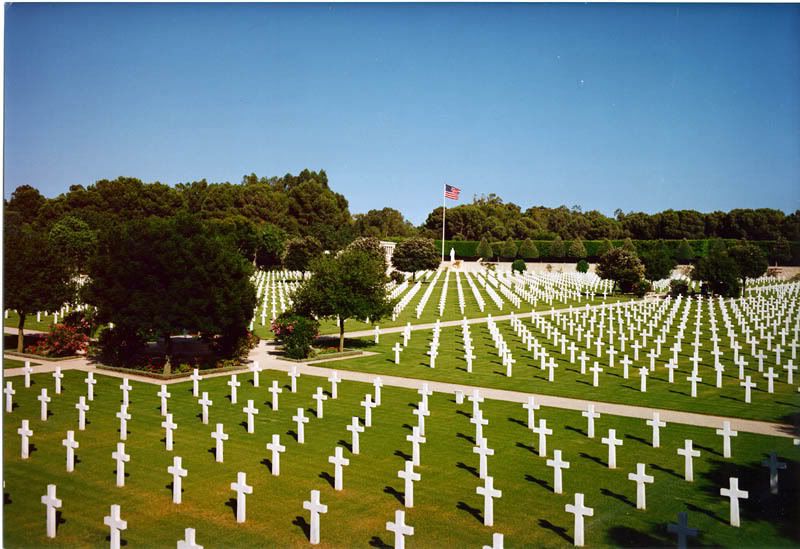
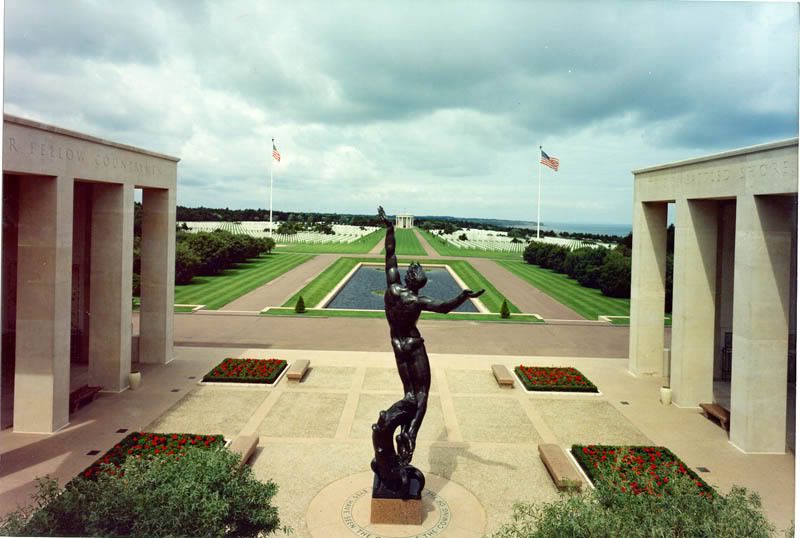 The Normandy American Cemetery and Memorial in France is located on the site of the temporary American St. Laurent Cemetery, established by the U.S. First Army on June 8, 1944 and the first American cemetery on European soil in World War II. The cemetery site, at the north end of its ½ mile access road, covers 172.5 acres and contains the graves of 9,387 of our military dead, most of whom lost their lives in the D-Day landings and ensuing operations. On the Walls of the Missing in a semicircular garden on the east side of the memorial are inscribed 1,557 names. Rosettes mark the names of those since recovered and identified.
The memorial consists of a semicircular colonnade with a loggia at each end containing large maps and narratives of the military operations; at the center is the bronze statue, "Spirit of American Youth." An orientation table overlooking the beach depicts the landings in Normandy. Facing west at the memorial, one sees in the foreground the reflecting pool; beyond is the burial area with a circular chapel and, at the far end, granite statues representing the U.S. and France.
The cemetery is open daily to the public from 9 a.m. to 5 p.m. except December 25 and January 1. It is open on host country holidays. When the cemetery is open to the public, staff members are on duty in the Visitor Center to answer questions and escort relatives to grave and memorial sites.
How to Get There
Normandy American Cemetery sits on a cliff overlooking Omaha Beach and the English Channel, east of St. Laurent-sur-Mer and northwest of Bayeux in Colleville-sur-Mer, 170 miles west of Paris. The cemetery may be reached by automobile via highway A-13 to Caen, then N-13 to Bayeux and Formigny, continuing on D-517 towards St. Laurent-sur-Mer and D-514 to Colleville-sur-Mer, where signs mark the entrance to the cemetery. There is rail service between Paris (Gare St. Lazare) and Bayeux, where taxicab and tour bus service is available; travel by rail takes 3 hours. Hotels are available at Bayeux and Port-en-Bessin.
The Normandy American Cemetery and Memorial in France is located on the site of the temporary American St. Laurent Cemetery, established by the U.S. First Army on June 8, 1944 and the first American cemetery on European soil in World War II. The cemetery site, at the north end of its ½ mile access road, covers 172.5 acres and contains the graves of 9,387 of our military dead, most of whom lost their lives in the D-Day landings and ensuing operations. On the Walls of the Missing in a semicircular garden on the east side of the memorial are inscribed 1,557 names. Rosettes mark the names of those since recovered and identified.
The memorial consists of a semicircular colonnade with a loggia at each end containing large maps and narratives of the military operations; at the center is the bronze statue, "Spirit of American Youth." An orientation table overlooking the beach depicts the landings in Normandy. Facing west at the memorial, one sees in the foreground the reflecting pool; beyond is the burial area with a circular chapel and, at the far end, granite statues representing the U.S. and France.
The cemetery is open daily to the public from 9 a.m. to 5 p.m. except December 25 and January 1. It is open on host country holidays. When the cemetery is open to the public, staff members are on duty in the Visitor Center to answer questions and escort relatives to grave and memorial sites.
How to Get There
Normandy American Cemetery sits on a cliff overlooking Omaha Beach and the English Channel, east of St. Laurent-sur-Mer and northwest of Bayeux in Colleville-sur-Mer, 170 miles west of Paris. The cemetery may be reached by automobile via highway A-13 to Caen, then N-13 to Bayeux and Formigny, continuing on D-517 towards St. Laurent-sur-Mer and D-514 to Colleville-sur-Mer, where signs mark the entrance to the cemetery. There is rail service between Paris (Gare St. Lazare) and Bayeux, where taxicab and tour bus service is available; travel by rail takes 3 hours. Hotels are available at Bayeux and Port-en-Bessin.
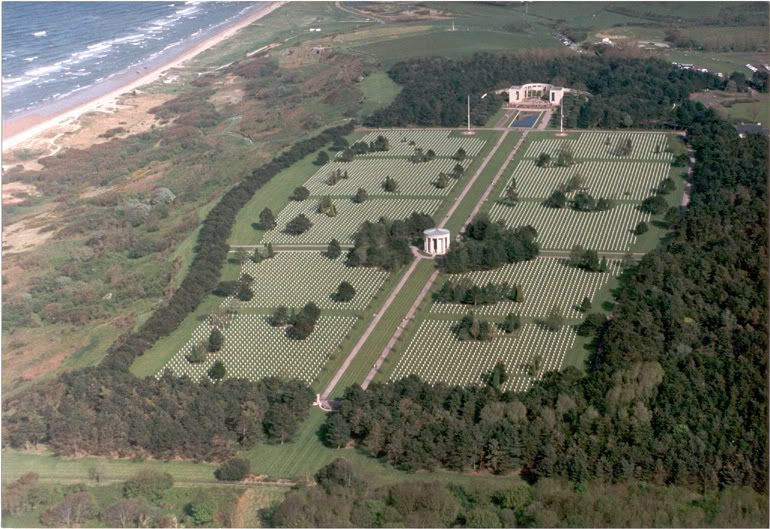
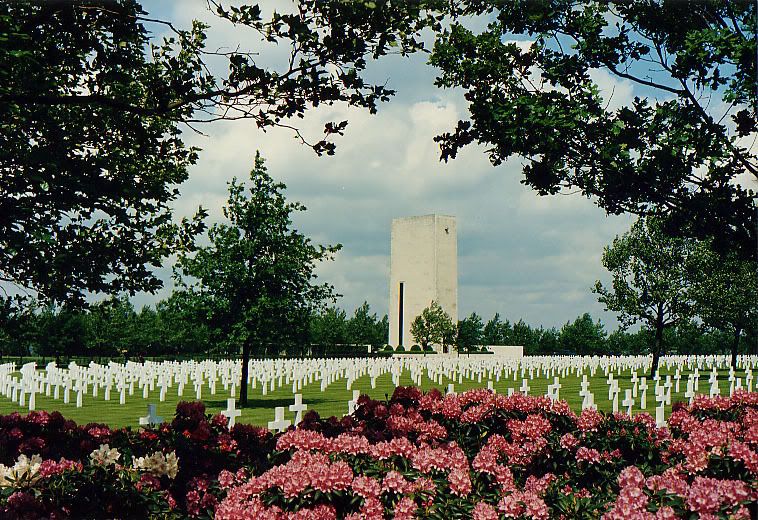 The World War II Netherlands American Cemetery and Memorial is the only American military cemetery in the Netherlands. The cemetery site has a rich historical background, lying near the famous Cologne-Boulogne highway built by the Romans and used by Caesar during his campaign in that area. The highway was also used by Charlemagne, Charles V, Napoleon, and Kaiser Wilhelm II. In May 1940, Hitler's legions advanced over the route of the old Roman highway, overwhelming the Low Countries. In September 1944, German troops once more used the highway for their withdrawal from the countries occupied for four years.
The cemetery's tall memorial tower can be seen before reaching the site, which covers 65.5 acres. From the cemetery entrance the visitor is led to the Court of Honor with its pool reflecting the tower. At the base of the tower facing the reflecting pool is a statue representing a mother grieving her lost son. To the right and left, respectively, are the Visitor Building and the map room containing three large, engraved operations maps with texts depicting the military operations of the American armed forces. Stretching along the sides of the court are Tablets of the Missing on which are recorded 1,722 names. Rosettes mark the names of those since recovered and identified.
Within the tower is a chapel. The light fixture in the chapel and the altar candelabra and flower bowl were presented by the government of the Netherlands and by the local Provincial administration. Beyond the tower is a burial area divided into 16 plots, where rest 8,301 of our military dead, their headstones set in long curves. A wide, tree-lined mall leads to the flagstaff that crowns the crest.
The cemetery is open daily to the public from 9 a.m. to 5 p.m. except December 25 and January 1. It is open on host country holidays. When the cemetery is open to the public, a staff member is on duty in the Visitor Building to answer questions and escort relatives to grave and memorial sites.
How to Get There
Netherlands American Cemetery lies in the village of Margraten, 6 miles east of Maastricht. Maastricht can be reached by train from Paris (Gare du Nord) via Liège, any city in Holland, or from Germany via Aachen. A bus service runs from Maastricht railroad station. Maastricht airport with taxicabs is 5 miles to the north; service should be verified.
The World War II Netherlands American Cemetery and Memorial is the only American military cemetery in the Netherlands. The cemetery site has a rich historical background, lying near the famous Cologne-Boulogne highway built by the Romans and used by Caesar during his campaign in that area. The highway was also used by Charlemagne, Charles V, Napoleon, and Kaiser Wilhelm II. In May 1940, Hitler's legions advanced over the route of the old Roman highway, overwhelming the Low Countries. In September 1944, German troops once more used the highway for their withdrawal from the countries occupied for four years.
The cemetery's tall memorial tower can be seen before reaching the site, which covers 65.5 acres. From the cemetery entrance the visitor is led to the Court of Honor with its pool reflecting the tower. At the base of the tower facing the reflecting pool is a statue representing a mother grieving her lost son. To the right and left, respectively, are the Visitor Building and the map room containing three large, engraved operations maps with texts depicting the military operations of the American armed forces. Stretching along the sides of the court are Tablets of the Missing on which are recorded 1,722 names. Rosettes mark the names of those since recovered and identified.
Within the tower is a chapel. The light fixture in the chapel and the altar candelabra and flower bowl were presented by the government of the Netherlands and by the local Provincial administration. Beyond the tower is a burial area divided into 16 plots, where rest 8,301 of our military dead, their headstones set in long curves. A wide, tree-lined mall leads to the flagstaff that crowns the crest.
The cemetery is open daily to the public from 9 a.m. to 5 p.m. except December 25 and January 1. It is open on host country holidays. When the cemetery is open to the public, a staff member is on duty in the Visitor Building to answer questions and escort relatives to grave and memorial sites.
How to Get There
Netherlands American Cemetery lies in the village of Margraten, 6 miles east of Maastricht. Maastricht can be reached by train from Paris (Gare du Nord) via Liège, any city in Holland, or from Germany via Aachen. A bus service runs from Maastricht railroad station. Maastricht airport with taxicabs is 5 miles to the north; service should be verified.
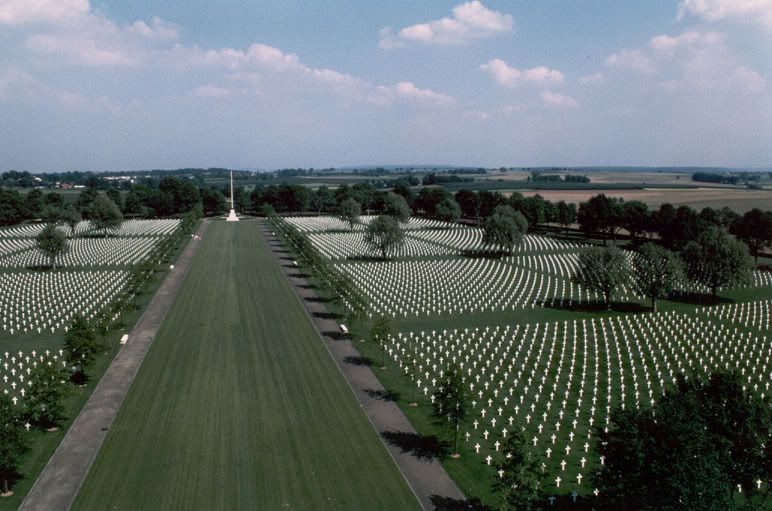
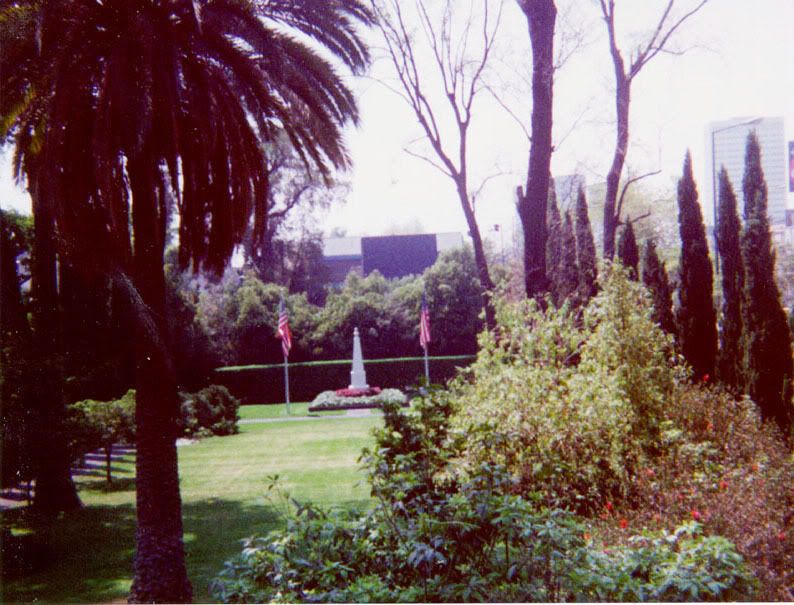 The Mexico City National Cemetery was established in 1851 by Congress to gather the American dead of the Mexican War that lay in the nearby fields and to provide burial space for Americans that died in the vicinity. A small monument marks the common grave of 750 unidentified American dead of the War of 1847. Inscribed on the monument are the words:
TO THE HONORED MEMORY
OF 750 AMERICANS
KNOWN BUT TO GOD
WHOSE BONES COLLECTED
BY THEIR COUNTRY'S ORDER
ARE HERE BURIED
In this 1-acre area are also placed 813 remains of Americans and others in wall crypts on either side of the cemetery. The cemetery was closed to further burials in 1923.
The cemetery is open daily to the public from 9 a.m. to 5 p.m. except December 25 and January 1. It is open on host country holidays. When the cemetery is open to the public, a staff member is on duty in the Visitor Building to answer questions and escort relatives to grave and memorial sites.
How to Get There
Mexico City National Cemetery is at 31 Virginia Fabregas, Colonia San Rafael about 2 miles west of the Metropolitan Cathedral and about 1 mile north of the U.S. Embassy.
The Mexico City National Cemetery was established in 1851 by Congress to gather the American dead of the Mexican War that lay in the nearby fields and to provide burial space for Americans that died in the vicinity. A small monument marks the common grave of 750 unidentified American dead of the War of 1847. Inscribed on the monument are the words:
TO THE HONORED MEMORY
OF 750 AMERICANS
KNOWN BUT TO GOD
WHOSE BONES COLLECTED
BY THEIR COUNTRY'S ORDER
ARE HERE BURIED
In this 1-acre area are also placed 813 remains of Americans and others in wall crypts on either side of the cemetery. The cemetery was closed to further burials in 1923.
The cemetery is open daily to the public from 9 a.m. to 5 p.m. except December 25 and January 1. It is open on host country holidays. When the cemetery is open to the public, a staff member is on duty in the Visitor Building to answer questions and escort relatives to grave and memorial sites.
How to Get There
Mexico City National Cemetery is at 31 Virginia Fabregas, Colonia San Rafael about 2 miles west of the Metropolitan Cathedral and about 1 mile north of the U.S. Embassy.